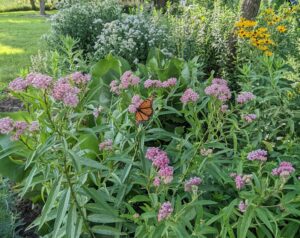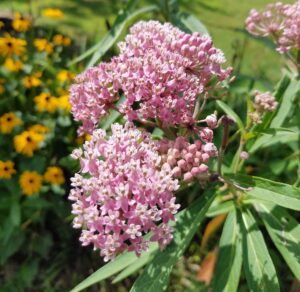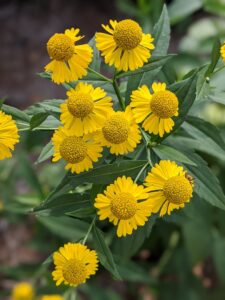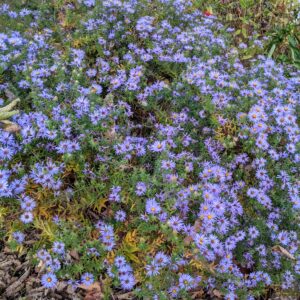Pollinator Plants for Your Garden — Part 4

This post wraps up our 4 part blog series describing 12 easy-to-grow plants for attracting pollinators (butterflies, bees, etc) to your garden. View earlier blog posts here.
The final three plants described in the post are swamp milkweed, sneezeweed and aromatic aster. All 12 species discussed in the series are available for free (while supplies last!) a locations around Petersburg–see December 12th blog for details.
Swamp Milkweed (Asclepias incarnata)

Milkweed seeds require 60 days of moist stratification (place in refrigerator with moist sand) prior to sowing. Can be started inside or sown directly outdoors. For optimal germination, sow indoors in seed starting mix with a dusting of mix or vermiculite to cover lightly. Keep seedlings evenly moist. When transplanting outdoors, select a full sun site. Will tolerate a wide range of soils, preferring moist sites, however, it is growing well on the square—definitely not a moist site!
At maturity, plants reach 3’-4’ and the showy pink flowers attract many butterflies, bees, and other pollinators while the plant serves as a host for monarch caterpillars. The plant is clump-forming, not spreading via roots like common milkweed, making it a great garden plant. It looks at right home in a perennial bed or allowed to gradually naturalize by seed in a meadow planting.
Sneezeweed (Helenium autumnale)

Don’t worry—sneezeweed doesn’t make you sneeze! It is insect-pollinated rather than having its pollen distributed by the wind. The common name comes from the historic use of the dried plant as a medicinal snuff. To grow it from seed, direct sow sneezeweed in spring, planting seeds 1/4″ deep and lightly compacting the soil. Iit does not require stratification, but it’s okay to winter sow it. Keep the soil lightly moist. Select a moist planting site in part to full sun. Prolific sunny yellow blooms beginning in August and bloom through early fall. It is a great food source for many butterflies, bees, and other pollinators and song birds feed on seed.
In its preferred habitat, it can get quite tall, up to 5’. To prevent flopping, pair it with other tall plants, opt to stake it, or trim it back in early summer to encourage compact growth.
Aromatic Aster (Symphyotrichum oblongifolium)

Direct sow aromatic asters in late fall through spring, sprinkling seed onto soil’s surface and very lightly covering. This species does not require stratification. Keep the soil lightly moist. Select a well-drained planting site in full sun. Tolerant of heat and drought. Usually well under 3’, but early summer pruning will encourage more compact growth. We usually do a little selective trimming on the square.
There are MANY native asters, but the compact size of this species really makes for a nice garden plant. It is among the latest bloomers, usually late September into November, so those end-of-season blooms provide a great food source for many butterflies, bees, and other pollinators when few others are available. It also serves as a host plant for a number of butterflies and moths, and birds feed on the seeds. It will spread by rhizomes and seed, so it works well in matrix plantings where the goal is to fill space. Try pairing it with short grasses, Amsonia with its golden fall foliage, or goldenrod.
This concludes our 4 part series, Pollinator Plants for Your Garden. We hope you found it useful and inspiring. Happy Gardening!


